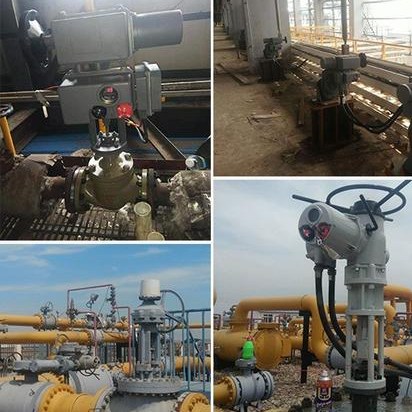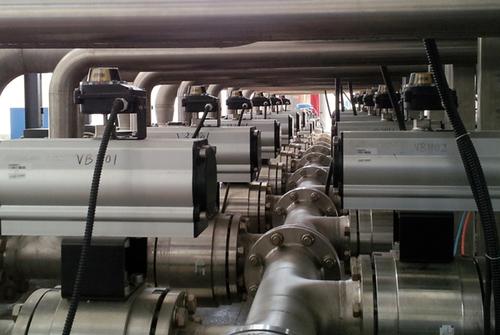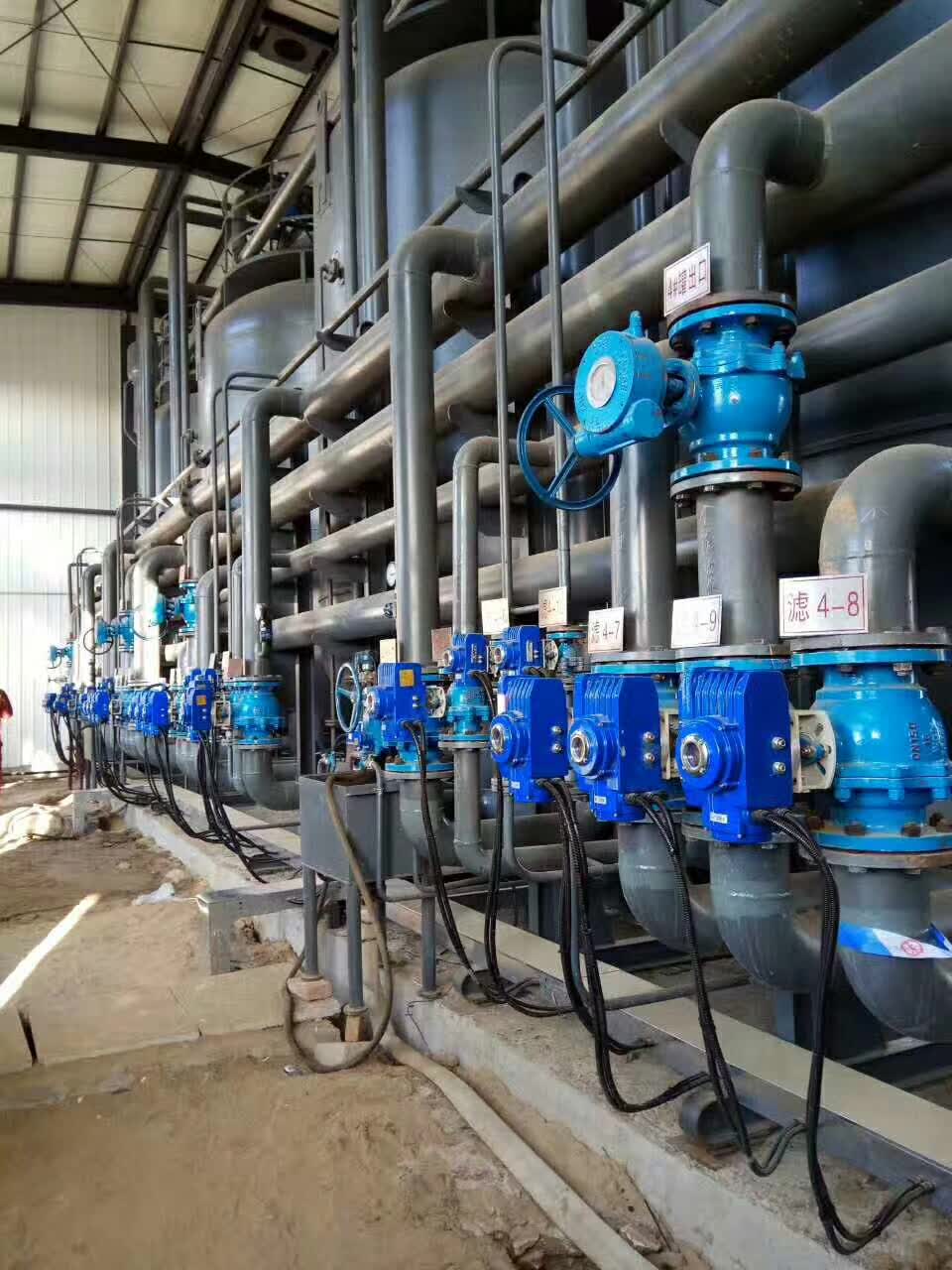
The actuator is the terminal control unit in the process control industry, which is usually composed of valve and actuator.
This article mainly discusses the differences and advantages of electric actuators and pneumatic actuators together with our comments from Zoyu Automatic Control (below referred to as ZYV)
Electric actuator: When the opening of the control valve need be changed, the motor needs to be driven, and the motor is powered off when the opening is reached. In the standby state, only a small amount of power is needed to maintain the operation of the control unit.
Pneumatic actuator: A certain amount of air pressure is required during the operation and standby state of the entire control valve. When the air pressure drops, the compressor must operate to increase pressure.
Comments by ZYV: Generally speaking, electric actuators are more energy-efficient than pneumatic actuators.
2. Application range
2.1 Action
Electric actuator: flexible configuration includes action modes of straight stroke, rotary stroke and multi-turn, which can be used to control all types of valves.
Pneumatic actuator: there are only two types of linear stroke and rotary stroke, which are usually used to control linear stroke control valves, butterfly valves, ball valves, etc.
Comments by ZYV: The electric actuator can conveniently realize the multi-turn action mode, and its structure is more flexible, especially for controlling gate valves, globe valves and other valves that are used in industrial sites.
2.2 High torque rotary stroke valve control
Electric actuator: It can realize the maximum torque above 100000 Nm, and the combination is flexible, the volume is relatively small, and it is easy to realize.
Pneumatic actuator: It can also achieve a torque not above 10000 of Nm, but the total size will be very large and not easy to install and use.
Comments by ZYV: For 90° rotary valves with larger torque (more than 10,000 Nm), it is usually more appropriate to use electric actuators.
2.3 Explosion-proof occasions
Electric actuators: Electrical and electronic components such as motors, control units, etc., may generate electric sparks when they are in a fault state, and require special explosion-proof treatment to be used in flammable and explosive situations.
Pneumatic actuator: The driving energy is air source (air or inert gas), so there are no high-voltage and strong electric components. It is not easy to generate electric sparks, and the safety performance is high.
Comments by ZYV: Some main equipment in petrochemical, metallurgical, coal chemical and other industries often contain flammable and explosive media such as oil, natural gas, and coal gas. For safety reasons, pneumatic actuators are usually used. Explosion-proof electric actuators are usually used in oil depots, tank farms, oil and gas pipelines, gas pipelines and other occasions where it is not convenient to lay gas lines.
3 Product performance
3.1 High temperature resistance
Electric actuator: Even if the controller is installed separately, the normal operation of the motor, sensor and other components in the main transmission structure is limited by the ambient temperature, and the ambient temperature is generally not more than 80°C.
Pneumatic actuator: After the valve positioner is installed separately, the main body (cylinder) can be selected with high temperature resistant products, and the high temperature resistance of the environment can reach 100 ℃ or higher.
Comments by ZYV: The working environment temperature of intelligent integrated electric and pneumatic actuators is similar. But after the control unit and the main body are installed separately, the pneumatic actuator is more resistant to high temperature than the electric actuator
3.2 Seismic performance
Electric actuator: It is composed of a large number of mechanical and electronic components, and its normal operation and life are greatly affected by vibration
.
Pneumatic actuator: the overall structure is simple, the movable parts are few, and it is not sensitive to vibration.
Comments by ZYV: Pneumatic actuators have stronger shock resistance.
3.3 Operating speed
Electric actuator: After decelerating through different types of gearboxes, different types of products have different output speeds, and the running speed is generally not adjustable.
Pneumatic actuator: it adjusts the operating speed according to the use demand through the air source signal, and can reach a faster operating speed.
Comments by ZYV: Pneumatic actuators can achieve rapid action response, and the speed can be adjusted to improve the efficiency of adjustment. Electric actuators need special motors and variable speed control modules to achieve speed regulation.
3.4 Overload capacity and life
Electric actuator: When the motor is frequently operated or overloaded beyond the use conditions, it is easy to generate heat, resulting in thermal protection and stoppage in the middle. Long-term heavy load will also increase the wear of the transmission gear.
Pneumatic actuator: it adapts to frequent full load action,having long operating life. The valve may increase the starting torque due to medium deposition. The use of pneumatic components can increase the working pressure and force within a certain range.
Comments by ZYV: Pneumatic actuators are more suitable for frequent and heavy-load adjustments. Regulating pneumatic actuators have a longer service life, up to 2 million operations. The operating cycle of the adjustable electric actuator can reach up to 1.8 million actions.
3.5 Hold function
Electric actuator: In the event of power failure, signal failure, etc., it can achieve position retention through its own mechanical self-locking.
Pneumatic actuator: Because of the compressibility of the air source, it is difficult to maintain position in the event of power failure, gas failure, and signal failure. It is necessary to add a combination system of retaining valve.
Comments by ZYV: Most electric actuators can achieve position retention. Pneumatic actuators need to be equipped with a positioner with a position retention function or an additional position retention valve, and a certain cost can be added to achieve the position retention.
3.6 Control accuracy
Electric actuator: it has good anti-deviation ability and stable output thrust or torque, which can well overcome the unbalanced force of the medium and achieve accurate control of process parameters. Usually the control accuracy of the intelligent electric actuator is 1%.
Pneumatic actuator: Because of the compressibility of the air source and the friction of the valve packing, valve stem, and process medium to overcome, it may cause a step change in the valve position and affect the positioning accuracy of the actuator. When the air source is stable, the control accuracy of domestic intelligent valve positioners can reach 1%, while the accuracy of some top positioners can achieve 0.1%.
Comments by ZYV: In terms of control accuracy, the control accuracy of pneumatic actuators is still higher than that of electric actuators.
3.7 Fail safe
Electric actuator: In the case of power loss, if you want to close or open the valve, you need to choose a capacitor reset or spring reset product.
Pneumatic actuator: In the case of loss of air source, the spring return function can be realized, which is easier to achieve than electric.
Comments by CFC: Although it is relatively easy for pneumatic actuators to realize the spring return function, long-distance transmission occasions such as petrochemical pipelines, due to their specific requirements, make spring return electric actuators widely applicable.
4 Use and maintenance
4.1 Post-maintenance
Electric actuator: complex structure, high degree of mechanical and electrical integration, including many moving parts, gears, circuit boards, etc., which require high technical requirements for equipment maintenance personnel
Pneumatic actuator: simple structure, only one moving part, low requirements for maintenance personnel

4.2 Operational safety
Electric actuator: generally 380V or 220V voltage, which is dangerous.
Pneumatic actuator: no high voltage

5 Common misunderstandings
5.1 The operating speed of electric actuators is slow. Should valves of quick opening and closing choose pneumatic actuators?
ZYV: For rotary stroke electric actuators, it is impossible to achieve a running time of less than 10s/90°. In fact, by configuring a high-power and high-speed motor and an appropriate deceleration mechanism, the function of rapid operation can be realized.
5.2 Pneumatic actuator structure is simpler and more economical than electric actuator?
ZYV: The structure of electric actuators is complex, including motors, servo controls, reducers, etc., and the price is higher. Although the price of a single pneumatic actuator is indeed not high, for a closed-loop control loop pneumatic actuator, including pneumatic actuator, valve positioner, servo amplifier, solenoid valve, retaining valve, air filter pressure reducer, position feedback system And so on, coupled with the need to configure gas sources, build compressor stations, and lay pipelines, the overall cost is not low.
5.3 Pneumatic actuator technology is mature, and its reliability is far better than electric actuator?
ZYV: In addition to the maturity of the product's own technical links, the guarantee of product reliability is also closely related to factors such as product selection, field application conditions, and product quality control system. Modern intelligent electric actuators are very mature in both transmission technology and control technology, and the supporting software and hardware are also guaranteed by mature technology, especially the reliability of the products of well-known foreign brand manufacturers. Modern pneumatic actuators have mature technology, few moving parts, simple structure, and with appropriate valve positioners, overall they have high reliability.
5.4 The degree of intelligence of electric actuators is higher than that of pneumatics?
ZYV: The two types of products have the same degree of intelligence. Both smart electric actuators and smart pneumatic valve positioners are continuously developing: human-machine interface, fault diagnosis, fieldbus, and wireless communication. Therefore, it cannot be said that electric represents high technology and pneumatic represents backward productivity.
In summary, whether electric or pneumatic actuators have their own product characteristics. When selecting models, it is necessary to combine on-site working conditions, consider various factors, eliminate misunderstandings, and choose products that suit their own conditions to achieve valve automation control.
Contact: Zhang Heng (Bill )
Phone: 86 13634285240
Tel: 86 0577 86915200
Email: cspneumatic@hotmail.com
Add: Yongqiang High Technology Developing Zone, Wenzhou, China.